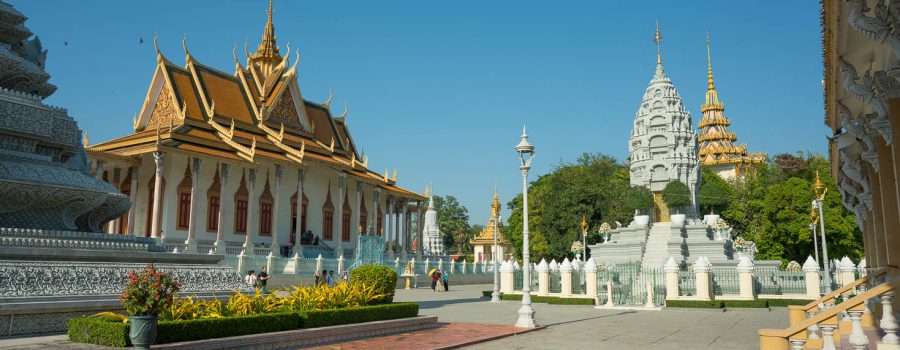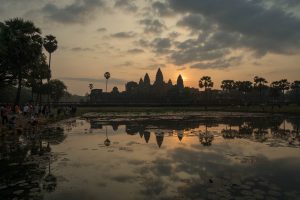After having visited Seam Reap, a highly touristic city without any charm, and Battambang, a much less touristic city but again without any charm, we were really looking forward to moving on to Phnom Penh, Cambodia’s capital. We were expecting a good mix between history, culture, and modern city life. But looking back, Phnom Penh did unfortunately also not live up to our expectations and we were happy to leave the city after three days.
The Genocide Museums in Phnom Penh
After having seen the Killing Caves in Battambang, we were slightly prepared to what we encounter when visiting the infamous Tuol Sleng and the Killing Fields museum in Phnom Penh which remember of the genocide that happened in Cambodia only 40 years ago while the Khmer Rouge were in power. I don’t want to go too much into history in this blog post, but for everybody who is interested in learning who the Khmer Rouge were and why they killed millions of innocent Cambodian citizens, I can recommend reading https://en.wikipedia.org/wiki/Khmer_Rouge .
As a short summary, the Khmer Rouge was a communist movement that developed in the late 60s and with strong support from China and northern Vietnam wanted to impose a pure communist system on Cambodia. In 1975, the Khmer Rouge’s army entered Phnom Penh and overthrew the corrupt military dictatorship. In a first step, all people were driven out of the big cities, incl. Phnom Penh and were forced to work in agriculture in order to make Cambodia a self-sufficient country. In the following 4 years, people with different views or which the Khmer Rouge suspected of being threats to the political system, were arrested, tortured, and executed once a confession has been signed. And the prisoners were tortured in the worst ways imaginable until they signed a confession of their crimes they did not commit. There was basically no way for a prisoner to get out again as from the regime’s point of view, it is impossible that they imprisoned someone by mistake. And worst of all, once a victim signed a confession, all its family members were imprisoned as well.
Although there are now exact numbers, it is estimated that 1.5 – 3 million Cambodian citizens were killed during the four years of genocide, and it is only thanks to the Vietnamese that defeated the Khmer Rouge in 1979 that this number is not even higher.
Tuol Sleng Prison
Tuol Sleng was only one out of many prisons over the whole country. It was established in a former school complex where the class rooms were transformed into prison cells and torture rooms. Up to 50 prisoners were locked up into a single class room whenever they were not being tortured. Nowadays it is a museum that displays the unfiltered truth of what was happening here during the years of the Khmer Rouge, the torture chambers, the tools, the prison cells, and the pictures of thousands of the victims that were found in the archive once the Khmer Rouge’s soldiers were driven out of town by the Vietnamese in 1979.
The Killing Fields
Once a prisoner has signed his confession, he was removed from the prison with dozens of other prisoners during the night, transported secretly outside of town to a place that is now called the Killing Fields. There, the prisoners were brought to the edge of a mass grave and beaten to death with primitive tools such as hammers, machetes, bamboo sticks, and so on. The reason was that bullets were too expensive and would make too much noise. Afterwards their body was dumped into a mass grave. Some of them held up to 450 bodies.
When the Killing Fields were discovered after the liberation from the Khmer Rouge, all the mass graves were exhumed, so nowadays the graves are mostly empty. But during heavy periods of rain, some bones still make it to the surface. In memory to all the victims killed here, a pagoda containing hundreds if not thousands of skulls was erected on the site.








The Royal Palace
The cultural highlight of Phnom Penh is the royal palace which is located east of the city center at the Mekong River. On 17 hectares, there are numerous beautiful buildings such as the throne hall, the Moonlight Pavilion, the Silver Pagoda, and a few more. As the king also resides in this area, some parts of the Royal Palace were closed to public. What I liked a lot when visiting is that the palace is by no means as overrun as Angkor Wat near Siem Reap or the Royal Palace in Bangkok. One of the reasons might be that the admission fee for the temple was $10 each, which seems a little overpriced for what it had to offer. But nevertheless, I do not regret having visited the palace.








The National Museum
Now we get to the cultural lowlight of Phnom Penh. Having visited the beautiful National Museum in Siem Reap a few days ago, we thought that the capital’s National Museum has at least as much to offer. Unfortunately that was not the case at all. First, when arriving, we saw that the admission has just recently been doubled to $10 (excl. audio guide). And second, I have never ever seen such a poorly maintained museum before. It was dirty everywhere inside, and as it was an open air museum, birds flew through the museum and released their excrements on whatever was underneath. Nobody in the museum seemed to feel responsible to clean the descriptions of the exhibition items from the bird shit, the floor was dirty, and the exhibition items themselves were also only in mediocre condition. What a shame. As taking pictures was forbidden inside the museum, you just have to believe me on that.
Phnom Penh as a City
Apart from the few attractions above, Phnom Penh is really nothing special. It is just another big cities, and not a particularly beautiful one. The food was very good in general, we got to enjoy some Moroccan, Indian, and local dinners while we were there.
But traffic was just insane. There is traffic jam everywhere, people driving as if there were no rules, and worst of all, even when walking on foot, it was dangerous as the whole sidewalk was parked with cars and motorbikes and hence we had to walk on the streets every now and then. So in the end we always hired a Tuk Tuk for getting from one place to another. Not because of laziness, but for safety reasons.
Also, there are some safety concerns when walking on the streets in Phnom Penh. When we arrived in Phnom Penh, our driver warned us about bag snatching that has become very popular in Phnom Penh. Bag Snatching means, that two people on the motorcycle drive next to you, grab your bags, with force if necessary, and drive away with it. As people tend to hold on to their bags, in addition to the loss of valuables, there are regular injuries of the victims due to being dragged behind the motorcycle. Luckily, Ilinca and I have not been confronted with it, but some friends we met the same day reported that they observed that someone almost had his phone ripped out of his hands on the street. And on the same day, my friend’s kindle had been stolen out of his back pocket.
After hearing all these stories, we were both not enjoying Phnom Penh that much anymore and we were glad to leave the city again after three days.




















